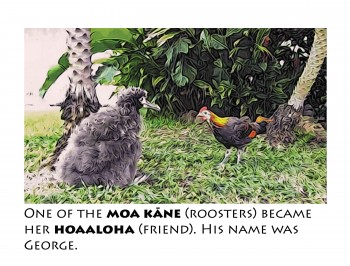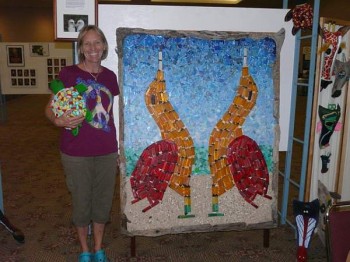Kaloakulua must now be pretty famous. The offspring of Kaluahine and Kaluakane, a pair of Laysan Albatrosses Phoebastria immutabilis on the north-east shore of the USA’s Kauai Island, its growth from hatching to fledging was livestreamed for 148 days last year to thousands of online viewers by a “trosscam” operated by the Cornell Laboratory of Ornithology.
Seen the movie, now read the book!
Susan Dierker, a resident of Kauai, has written an account for children of Kaloakulua’s first year of life as a chick. The hard-cover book of 44 pages is made up Susan’s evocative paintings of special scenes captured by the remote camera. These include Kaloakualua (designated to be a female) being visited by a rooster called George, checking out some passing egrets and meeting up with Mango, another Laysan chick from a nearby nest. At the end of the book the chick successfully fledges and flies out to sea.

Having brought up a daughter who had books read to her nightly until she could read them herself, I can classify children’s picture books into three types. First, books with just illustrations for very young children, then those with a simple text for each picture so you can allow the child to see and follow the words you are reading out, then for older children those books where you can help them spell out the text themselves. I place Susan Dierker’s nicely printed and bound book in between the second and third categories. In fact, I wish I had it two decades back to read out at bedtime.
The short sentences accompanying each painting are all in large capitals and many of the words used come with their Hawaiian versions (for example a Laysan Albatross is a Mōlī and a chicken is a Moa).
The DVD has 10 clips from the livestreaming camera that well complement the book, including KK’s interaction with George. All in all the book and DVD make a nice package to help persuade your offspring that albatrosses are seriously cool.

Kauai’s trosscam is back in operation again this year, following two nests that are hatching right now (click here); another book, Susan?
Click here to view ACAP’s listing of other children’s books on albatrosses and petrels: it’s been visited over 4700 times.
Reference:
Dierker, Susan 2014. Albatross of Kaua’i. The Story of Kaloakulua. Hanalei: Done by Dogs Publishing. Unpaginated [44 pp] + DVD. ISBN 978-0-9832386-2-1. Hard cover with coloured illustrations. US$ 20.00. www.albatrossofkauai.com.
John Cooper, ACAP Information Officer, 02 February 2014


 English
English  Français
Français  Español
Español 




